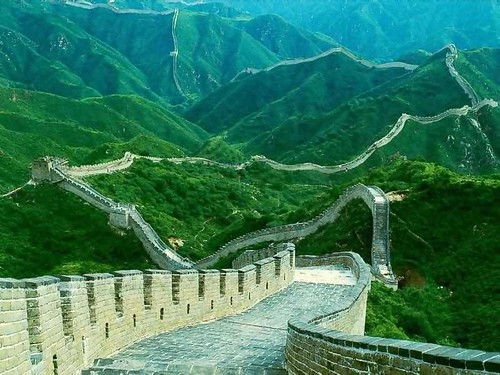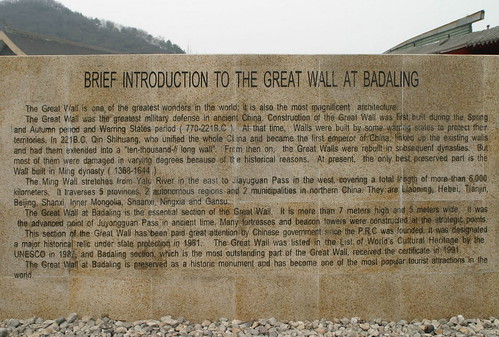

The Great Wall of China is a series of stone and mud fortifications in China, built, rebuilt, and between the 5th Century BC and the 16th Century to protect the northern border of the Chinese Empire during the reign of the subsequent dynasties. Several walls, as the Great Wall of China, have been since 5 Century BC, the most famous is the one built between 220 BC and 200 BC by the first emperor of China, Qin Shi Huang. This wall was much further north than the current wall, during the Ming Dynasty, and there remains little.
The Great Wall is the world's longest human-made structure, stretching over approximately 6,400 km (4,000 miles) from Shanhai Pass in the east to Lop Nur in the west, along an arc that roughly delineates the southern edge of Inner Mongolia. It is also the largest human-made structure ever built in terms of surface area and mass.
History
The Chinese were already familiar with the techniques of wall-building by the time of the Spring and Autumn Period, which began around the 8th century BC. During the Warring States Period from the 5th century BC to 221 BC, the states of Qi, Yan and Zhao all constructed extensive fortifications to defend their own borders. Built to withstand the attack of small arms such as swords and spears, these walls were made mostly by stamping earth and gravel between board frames.
 Qin Shi Huang conquered all enemy states and united China in 221 BC, to the founding of the Qin Dynasty. Do the imposition of central rule and prevent the resurgence of feudal lords, he ordered the destruction of the dividing wall sections that his former empire along the state border. To guard against intrusions into the realm of the Xiongnu people from the north, he ordered the construction of a new wall to connect the remaining fortifications along the northern reach of the new border. The transportation of large quantities of materials needed for the construction was difficult, the builders always tried to use local resources. Stones from the mountains, over mountain ranges, while rammed earth were for the construction in the plains. There are no surviving historical records indicating the exact longitude and of course the Qin Dynasty walls. Most of the ancient walls have eroded over the centuries, and only a few sections remain today. Later, Han, Sui, Northern and Jin Dynasty all repaired, rebuilt, expanded or parts of the Great Wall at great cost to defend itself against the northern invaders.
Qin Shi Huang conquered all enemy states and united China in 221 BC, to the founding of the Qin Dynasty. Do the imposition of central rule and prevent the resurgence of feudal lords, he ordered the destruction of the dividing wall sections that his former empire along the state border. To guard against intrusions into the realm of the Xiongnu people from the north, he ordered the construction of a new wall to connect the remaining fortifications along the northern reach of the new border. The transportation of large quantities of materials needed for the construction was difficult, the builders always tried to use local resources. Stones from the mountains, over mountain ranges, while rammed earth were for the construction in the plains. There are no surviving historical records indicating the exact longitude and of course the Qin Dynasty walls. Most of the ancient walls have eroded over the centuries, and only a few sections remain today. Later, Han, Sui, Northern and Jin Dynasty all repaired, rebuilt, expanded or parts of the Great Wall at great cost to defend itself against the northern invaders. The Great Wall concept was revived again during the Ming Dynasty following the Ming army's defeat by the Mongols in the Battle of Tumu in 1449. The Ming had failed to gain a clear upper-hand over the Mongols after successive battles, and the long-drawn conflict was taking a toll on the empire. The Ming adopted a new strategy to keep the Mongols out by constructing walls along the northern border of China. Acknowledging the Mongol control established in the Ordos Desert, the wall followed the desert's southern edge instead of incorporating the bend of the Huang He.
The Great Wall concept was revived again during the Ming Dynasty following the Ming army's defeat by the Mongols in the Battle of Tumu in 1449. The Ming had failed to gain a clear upper-hand over the Mongols after successive battles, and the long-drawn conflict was taking a toll on the empire. The Ming adopted a new strategy to keep the Mongols out by constructing walls along the northern border of China. Acknowledging the Mongol control established in the Ordos Desert, the wall followed the desert's southern edge instead of incorporating the bend of the Huang He.Unlike the earlier Qin fortifications, the Ming construction was stronger and more elaborate due to the use of bricks and stone instead of rammed earth. As Mongol raids continued periodically over the years, the Ming devoted considerable resources to repair and reinforce the walls. Sections near the Ming capital of Beijing were especially strengthened.
Towards the end of the Ming Dynasty, the Great Wall helped defend the empire against the Manchu invasions that began around 1600. Under the military command of Yuan Chonghuan, the Ming army held off the Manchus at the heavily fortified Shanhai Pass, preventing the Manchus from entering the Liaodong Peninsula and the Chinese heartland. The Manchus were finally able to cross the Great Wall in 1644, when the gates of Shanhai Pass were opened by Wu Sangui, a corrupt Ming border general, after being bribed. The Manchus quickly seized Beijing, and defeated the remaining Ming resistance, to establish the Qing Dynasty.
Under Qing rule, China's borders extended beyond the walls, and Mongolia was annexed into the empire, so construction and repairs on the Great Wall were discontinued.
Visibility
Visibility from the moon
 Ripley's Believe It or Not! cartoon from May 1932 makes the claim that the wall is "the mightiest work of man, the only one that would be visible to the human eye from the moon" and Richard Halliburton's 1938 book Second Book of Marvels makes a similar claim. This belief has persisted, assuming urban legend status, sometimes even entering school textbooks. Arthur Waldron, author of history of the Great Wall, has speculated that the belief might go back to the fascination with the "canals" once believed to exist on Mars. (The logic was simple: If people on Earth can see the Martians' canals, the Martians might be able to see the Great Wall.)
Ripley's Believe It or Not! cartoon from May 1932 makes the claim that the wall is "the mightiest work of man, the only one that would be visible to the human eye from the moon" and Richard Halliburton's 1938 book Second Book of Marvels makes a similar claim. This belief has persisted, assuming urban legend status, sometimes even entering school textbooks. Arthur Waldron, author of history of the Great Wall, has speculated that the belief might go back to the fascination with the "canals" once believed to exist on Mars. (The logic was simple: If people on Earth can see the Martians' canals, the Martians might be able to see the Great Wall.)The Great Wall is a maximum 30 ft (9.1m) wide and is about the same color as the soil surrounding it. Based on the optics of resolving power (distance versus the width of the iris: a few millimetres for the human eye, metres for large telescopes) an object of reasonable contrast to its surroundings some four thousand miles in diameter (such as the Australian land mass) would be visible to the unaided eye from the moon (average distance from earth 238,857 miles (384,393 km)). But the Great Wall is of course not a disc but more like a thread, and a thread a foot (15 cm) long would not be visible from a hundred yards (90 m) away, even though a human head is. Not surprisingly, no lunar astronaut has ever claimed he could see the Great Wall from the moon.
Visibility from near earth orbit
 A different question is whether it is visible from near-Earth orbit, i.e at an altitude of less than 500 kilometers (311 mi) (0.1% of the distance of the moon). The consensus here is that it is barely visible, and only under nearly perfect conditions; it is no more conspicuous than many other manmade objects.
A different question is whether it is visible from near-Earth orbit, i.e at an altitude of less than 500 kilometers (311 mi) (0.1% of the distance of the moon). The consensus here is that it is barely visible, and only under nearly perfect conditions; it is no more conspicuous than many other manmade objects.Astronaut William Pogue thought he had seen it from Skylab but discovered he was actually looking at the Grand Canal of China near Beijing. He spotted the Great Wall with binoculars, but said that "it wasn't visible to the unaided eye." US Senator Jake Garn claimed to be able to see the Great Wall with the naked eye from a space shuttle orbit in the early 1980s, but his claim has been disputed by several US astronauts. Chinese astronaut Yang Liwei said he could not see it at all.
Veteran US astronaut Gene Cernan has stated: "At Earth orbit of 160 kilometers (99 mi) to 320 kilometers (199 mi) high, the Great Wall of China is, indeed, visible to the naked eye." Ed Lu, Expedition 7 Science Officer aboard the International Space Station, adds that, "it's less visible than a lot of other objects. And you have to know where to look."
Neil Armstrong explained about the prospect of Apollo 11: "I do not believe that at least in my eyes, there would be no man-made objects, which I could see. I have not yet found somebody who told me that she had seen , The Wall of China from Earth orbit. ... I have asked various people, especially boys shuttle, which have many cars around China in the day, and those who I have spoken to do not see him . "
Leroy Chiao, a Chinese-American astronaut, took a photograph from the International Space Station that shows the wall. It was so indistinct that the photographer was not certain he had actually captured it. Based on the photograph, the state-run China Daily newspaper concluded that the Great Wall can be seen from space with the naked eye, under favorable viewing conditions, if one knows exactly where to look.
From Wikipedia, the free encyclopedia
Video from Metacafe
No comments:
Post a Comment